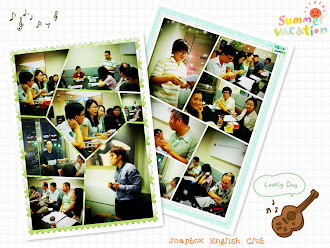聚會時間 晚上7:00--7:25 請準時 謝謝
Deep Patel forbes
1. Let It Go
Often we so dread interacting with someone we dislike that our anxiety levels start mounting before we even step into the room with that person. When your nerves are jangling, it can be all too easy to overreact and jump down someone’s throat or say something you might regret.
Emotions are like a genie: once you let them out of the bottle, it’s hard to get them back under control. So if you know you’ll be dealing with someone who stresses you out, take a deep breath and channel your inner Zen. Quiet your mind. Adopt a “let it go” attitude. If you feel your ire start to rise, focus on listening more and talking less. Remember, you don’t have to eat words you never say.
2. Focus On Healthy Ways To Communicate
If you find yourself dealing with someone who gives you chronic hives, it’s time to find a way to calmly but assertively express how you feel. Most problems stem from the way we communicate with each other. Instead of reacting (which often means overreacting), try explaining how you feel in a nonconfrontational tone. One of the best ways of doing this is by making “I” statements.
An “I” statement uses the formula: “When you ___, I feel ___.” You might say something like: “When you focus on your phone instead of looking at me when I’m talking, I feel like you’re not valuing what I have to say.” Then wait to hear how the other person responds. Be specific about which behaviors make you upset and what you would like them to do to correct the problem. Once you’ve made your point, be sure to listen to their side.
3. Practice Civility
Extending common courtesies to everyone is a good rule of thumb, no matter who you are dealing with. Treating everyone with politeness and respect, even when you disagree, will create a baseline of civility. That means treating others as you want to be treated. Even small gestures of kindness can help ease tensions and forge goodwill.
Put on your best manners and focus on handling situations with grace and poise. If you do so, those around you will respect you and see you as having integrity. Avoid personal attacks and consistently act with a level of decorum and you’ll have the upper hand when dealing with those who want to tear you down.
4. Sidestep When Possible
The reality is that dealing with a difficult person can be similar to picking your way through a minefield. For example, you may know that certain topics are hot-button issues with a person. If that’s the case, it may be best to sidestep certain conversations.
Yes, you should be able to voice your concerns, and picking your battles doesn’t mean avoiding confrontation altogether. But you should also think carefully about what you decide to tackle and when—many of our problems are situational and may dissipate with time. Consider what issues are worth your time and what you’re feeling emotionally up for dealing with. If someone wants to discuss something you know is going to make you (or them) see red, calmly tell them you want to table that discussion for the time being.
5. Fake It Till You Make It
Staying composed isn’t always easy, especially when dealing with someone who grates on your nerves. Instead of trying to beat them at their own game, it may be time to bluff your way out.
Think of this as an opportunity to perfect your ultimate poker face. If this were a game of high-stakes cards, you would do everything in your power to conceal your hand. You would be deadpan, showing only what you want to show. This in essence is how you distance yourself from someone emotionally, and it’s a great way to give yourself emotional space during difficult situations.
6. Be Mindful Of Your Emotions
While you may be practicing presenting an expressionless face to the world, don’t attempt to ignore your emotions altogether. Though emotional distance means keeping someone at arm’s length, you also have to stay mindful of how you are feeling. You can’t stop someone from pushing your buttons if you don’t know when it’s happening.
So take note of your inner emotional rollercoaster. What is this person saying or doing to tick you off? By recognizing what is going on with you internally, you can take steps to keep them from doing it again, such as knowing when to disengage. Find a way to give yourself space to regroup and move on.
7. Put A Positive Spin On It
If you have to deal on an ongoing basis with someone you dislike, it may be helpful to try to put a positive spin on how you perceive them, or at least have fewer negative assumptions about them.
So instead of focusing on a pessimistic thought (“My co-worker just looked at me and rolled her eyes — she must be thinking something negative about me!”), try to see it from a more neutral standpoint (“My co-worker rolled her eyes, but she might not have intended that toward me. She might just be thinking of something else, like how much work she has…”). Reframing it this way will allow you to feel less provoked and help you let little things go.
8. Find Common Ground
Instead of avoiding a person who drives you crazy, you may want to try spending a little more time with them. This probably goes against every fiber of your being, especially if the person makes your list of Top Most Annoying People. But if you spend a little more time getting to know them, such as working on a project with them, you’ll get to understand them better.
As they say: walk a mile in another person’s shoes and you will see things from their perspective. Taking the time to understand a person you dislike can help you have more empathy and compassion for them. You may see that there are reasons they are the way they are. Being able to build a rapport with them will help you bridge those frustrating communication gaps. You may even find that you have more in common than you imagined.
9. Recognize The Value In Differing Opinions
Understanding other people’s perspectives is an important leadership skill. After all, managers and leaders are called on to oversee people from a variety of backgrounds.
From the standpoint of getting the best performance out of your employees, it doesn’t really matter if you like them or not; nor does it matter if they like you. In fact, it can be helpful to seek out the perspective of people with vastly different points of view. They may be able to offer unique insights that challenge and provoke new thinking.
10. Take A Good Look In The Mirror
If you’re having ongoing issues with someone and are having a hard time understanding why, you may want to look inward. Ask yourself what it is about this person that sets you off. Are you letting your sensitivities blow a situation out of proportion? Sometimes we let jealousy or envy get in the way.
Could resentment be playing a role in how you deal with this person? It can also be easy to misinterpret someone’s actions or read ulterior motives into them. Is there something in your own experiences that may be unfairly influencing how you see someone? It’s important to be aware of your own biases or preconceived notions. Recognizing that you share some of the blame may be the first step toward correcting a problem.
11. Find Your Circle Of Trust
Don’t attempt to tackle everything by yourself — that will only leave you feeling isolated and more frustrated. Try tapping into a support system. Turning to a trusted circle of friends will give you the space you need to feel heard, allowing you to vent and air your grievances.
A mentor or a trusted colleague may be able to offer advice on how to deal with a particularly touchy situation at work. Just knowing that someone understands what you are going through can be helpful. And your friends may be able to give you a new perspective on how to handle a challenging person.
12. Focus On Yourself
The bottom line is that you only have control over yourself and your own actions. Instead of fixating on how much you dislike someone or how angry they make you feel, focus on your strategy for handling them. Think about what you can do to limit their ability to get under your skin.
Don’t allow yourself to fall victim to a disagreeable person. They aren’t worth it. Remember, no one can drag you down and steal your joy unless you let them.
吸引力法則
How Does The Law Of Attraction Work? 6 Key Facts You Should Know
thelawofattraction
When you first start reading about manifestation techniques, it’s common to find yourself asking one major question: how does the Law of Attraction work? And even if you’ve been working to attract your dreams for a while, you might still find yourself getting more curious about the theoretical underpinnings of what you’re doing.
While there are many fascinating details and burgeoning areas of new research, here are the key facts you need to know about how the Law of Attraction works.
1. It Works Constantly
When thinking of questions about how the Law of Attraction works, people commonly assume that they can make it work at specific times or do something to bring it into their lives. What you need to understand is that the Law of Attraction is constantly working. It is influencing everything you do and experience throughout each day.
So, it makes more sense to think about how you can harness the power of the Law of Attraction, directing the associated energy in ways that allow you to get what you want.
Find out more about the science behind The Law Of Attraction now, just click here!
2. Your Frequency Determines Your Results
Whether you’re vibrating on a high or low frequency is the primary factor determining whether you successfully manifest your dreams. Given how the Law of Attraction works, you magnetically draw (i.e. attract) things vibrating on the same frequency. These are things that reflect your internal state.
This means that if you work to maintain a high frequency (though positivity, love, compassion, and productivity) then you inevitably end up with more good things in your life.
3. It Is Influenced By The Unconscious
You might think of yourself as a really positive person, but you may still attract negative things into your life due to unconscious parts of your mind. These parts are shaped by your genetic makeup and your underlying neurology, so you’re not to blame for their existence!
law-attraction-work There’s scientific proof that certain fears and limitations can be passed down from parent to children. However, the good news is that these parts of you can be slowly reprogrammed through techniques like affirmations and visualization.
4. The Intention Point Is The Seat Of Manifestation
My own Law of Attraction results improved dramatically once I discovered the Intention Point. If you want to learn more about the specifics, dive into “Origins” and learn how to identify and influence this crucial part of you.
With respect to how the Law of Attraction works though, the main thing you need to know is that the Intention Point is the powerful space that connects your heart and mind. Once you find it in yourself, you can use its position to assess your needs and figure out what might be blocking your manifestation work.
In essence, it’s the electric field of your heart, which studies show generates 5,000 times more magnetic power than that of the brain.
5. What You Focus On Is What You Receive
Just as your underlying vibration attracts things vibrating on the same energetic frequency, the things you focus on are the things you’re most likely to get. Some people claim to be constantly focusing on what they want (e.g. financial abundance). However, if they’re not receiving it then they’re most likely focusing on the wrong aspect of what they want.
For example, they may be feeling desperately worried that they won’t get money when attracting money really requires feeling confident and excited about the fact that you will get money. The message here is that the Law of Attraction doesn’t just require you to keep your heart and mind full of your dreams. Instead, it requires you to do so in a way that is fully positive and trusting.
6. We’re Constantly Learning More About The Science
law-attraction-work
Although the Law of Attraction has been intermittently popular (in different ways and sometimes under different names), it has recently drawn sustained interest from scientists working in psychology, neurology and quantum physics.
As such, we’re discovering more and more about how our biology and the makeup of the Universe work in harmony to respond to the constant flow of energy. If you’re interested in learning more about this burgeoning research field, check out our coverage of some of the most exciting studies!
If there’s one thing you take away from this quick summary of how the Law of Attraction works, let it be this: the more time you spend learning how to work with the Law of Attraction, the more you will get back from the world around you. You have limitless potential, and so does the Universe! Be bold, and revel in the abundance that follows.
If this subject matter interests you, be sure to join Bob Doyle and Dr. Travis S. Taylor for a 3-part in-depth exploration into the Science Behind the Secret and claim the awesome creative power that is yours! Just click here now and gain immediate access to a treasure-trove of knowledge.
























